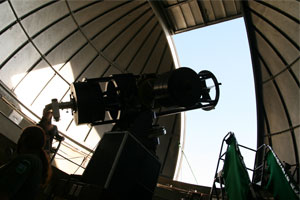Quadrantid Meteor Shower

Telescope at Goldendale Observatory.
When to go:
January 3, 2013
Where to go:
What to look for:
Look to the northern sky on the first few nights of January, especially the night of the 3rd. Bring a blanket, 'cause it will be cold!
-
60 Meteors a Minute
If there is no moon, the shower may produce as many as 60 meteors every minute. Unlike the more well-known summer meteor showers, the Quadrantids have a very brief peak period, which only lasts a few hours.
The Quadrantid meteor shower has been observed since the 1830s, and is named after the obsolete constellation Quadrans Muralis - now part of Boötes.
-
Satellites
While you watch for meteors, you may see a slow-moving spot of light that does not fade away like a shooting star. These are satellites, reflecting the light of the sun.
-
Bats & Owls
You may get lucky and see (or hear!) bats or owls while you're out stargazing. Youngsters are more likely to hear the very high-pitched squeaks of bats, but anyone can keep an ear out for owls.
What is a shooting star?
So-called shooting or falling stars are not actually stars. They are bits of dust and rock. Astronomers call them meteors. You can see meteors on any night of the year, but on certain nights there are enough to be called a meteor shower.
Meteor showers are usually named for the constellation they seem to be coming from - the Perseids seem to come from the constellation Perseus, while the Leonids seem to come from Leo. The meteors are not actually coming from these constellations, though.
When a comet or asteroid passes through the solar system, it can leave a trail of dust in its wake. If the Earth happens to pass through that trail of dust, some of the dust hits our atmosphere and burns up. That's a meteor shower! Since the Earth orbits the sun once a year, we pass through the same old comet trails at the same time every year. That allows astronomers (and you and me) to predict when meteor showers will happen.
Sources:
EarthSky, 2012
NASA Science, 2012
Images by Bernt Rostad
